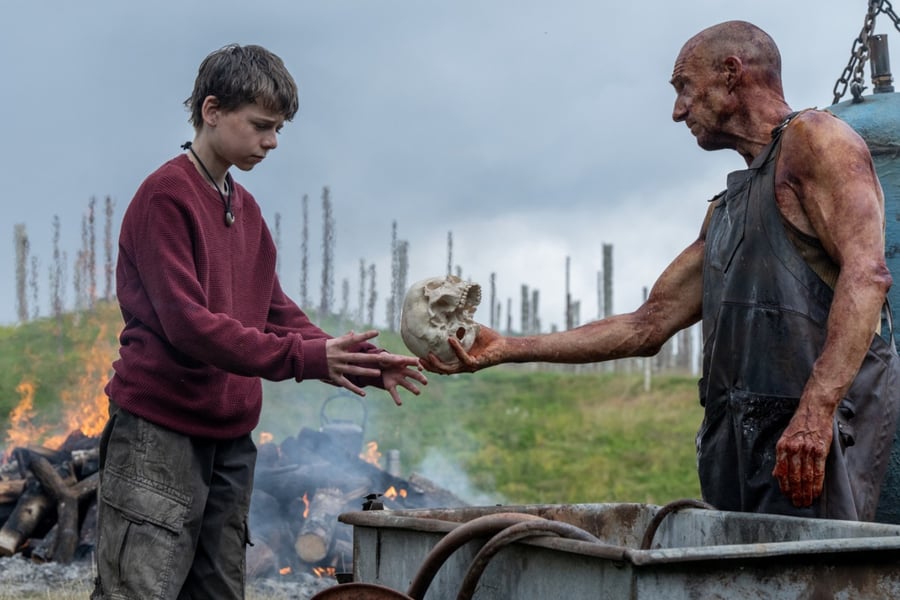A lot can happen in 20-plus years: careers can rise and fall, empires can crumble under their own weight, cult fan favorites can give birth to money-minting franchises, a minor horror subgenre can suddenly become ubiquitous. When director Danny Boyle and screenwriter (and future director) Alex Garland dreamed up 28 Days Later… in the early 2000s, there was no Zombie Entertainment Industrial Complex outside of the Romero classics and Resident Evil. The notion of a crippling global pandemic was relegated to war-room exercises and airport-read novels. “Intellectual properties” was primarily a legal term. A postapocalyptic landscape that had folks scrambling away from our once-friendly neighbors, whose brains were now infected by a contagious mass rage, felt far-fetched enough to be considered fiction.
For those of us who remember that first shock-to-the-system viewing of Boyle’s 2002 survivalist tale, the idea of returning to this world now was both welcome and worrying. There had been a sequel, 28 Weeks Later… (2007), in which the filmmaker simply lent his name as a producer and handed over the reigns to Spanish horror director Juan Carlos Fresnadillo. It was neither a vital continuation of the world-building nor a cheap cash-in. You didn’t necessarily leave the movie breathless for the next chapter. Not to mention that, though the rampaging rageaholics weren’t technically zombies, any itch for narratives involving pockets of humanity holding off hordes of the hungry undead would soon be scratched a hundredfold. An announcement that Boyle and Garland were considering returning for a third chapter was greeted as great news, but given the oversaturation of similar sagas that had sprung up in the original’s wake, would the series itself simply be considered old news? Even if this specific cinematic universe suddenly felt eerily relevant to our own?
To be fair, the duo’s 28 Years Later… misses syncing up its in-house timeline with an IRL one by five years. But who’s going to quibble over numbers when that’s the only thing that feels off in this revisiting of a Rage Virus-infected United Kingdom? Reuniting not just with Days’ scribe and producer Andrew McDonald but also Anthony Dod Mantle, the cinematographer who gave the original its era-defining digital images of social deterioration, Boyle has built a sturdy bridge between his chronicle of things falling apart at the beginning of the 21st century and the aftermath of that breakdown almost one quarter of a century into it. That he simply didn’t retroactively ruin the first film by releasing a new franchise-expanding, Easter-egg hunt of an entry just for the sake of it would’ve been enough. Yet the filmmaker and his collaborators have also deepened their vision of a world on the brink, adding in strong elements of British folk horror, anxiety over good-old-days nationalism and an emphasis on what happens to a generation growing up in the shadow of normalized chaos.
After a brief reintroduction of the pandemic’s early days — a house is overrun by the infected, a church becomes the scene of a slaughter, people done get bit — the movie fast-forwards to [checks notes] 28 years later, a makeshift community on an island off the northeast coast of England. This is the place that the 13-year-old Spike (Alfie Williams) calls home. His father, Jamie (Aaron Taylor-Johnson), is one of the group’s leaders. He’s about to take Spike on his first hunt on the mainland, which is only accessible by a causeway that appears during low tide. The boy is warned that, once he and his dad leave the heavily fortified walls of the compound, they are on their own. There will be no rescue parties.
Once they arrive at the ruins of what was once Britain, we get a better glimpse of what’s happened since we last visited this patch of scorched earth. For starters, the infected have mutated, transformed, and in some selective cases, evolved. You still have the sprinting dead, maniacally rushing and clawing to feed an insatiable appetite they don’t understand. But there also variations known as crawlers, sickeningly bloated creatures that slither on their bellies toward prey. There are emaciated ragers, having been starved due to a longstanding quarantine of the region. There are tribes of fast, feral predators that resemble the second coming of neanderthals. And then there is whatever has been hanging deer skulls, with full spines attached, to a number of trees that Spike and Jamie come across.
That turns out to be the handiwork of “the Alpha,” one of several apex virus-carriers that now reign supreme. This superior species of Homo infectus is stronger, faster and more advanced than your average viral lunatic. He’s the next step up the Darwinian chain, and when he begins running after the father and son, they’re barely able to make it back to home base alive. Spike has successfully gone through his rite of passage, yet he remains troubled. His mother, Isla (Jodie Comer), is sick. She’s not a carrier, but she is feverish, delirious, and losing her grip on reality. Supposedly, there was once a medical physician who fled deep into the land of the living dead and went insane. Spike slips out one morning with his mom when low tide hits, and goes in search of this mythic figure. If there’s even a chance this man can cure her….
From here, Boyle throws a number of obstacles in his heroes’ way, from a rager in the middle of giving birth to a lost Swedish soldier (Edvin Ryding) with a shoot-first-questions-later way of handling volatile situations. Eventually, they meet the mystery man who answers to the name of Dr. Kelson, who gives off major Colonel Kurtz vibes — and from the second a bald Ralph Fiennes shows up, covered head to toe in orange iodine, you can feel 28 Years Later… shift gears. You expect him to be one thing, and he turns out to be something else entirely, which doesn’t stop the Schindler’s List actor from playing this authority figure gone rogue with a gentleman’s politeness, a built-in sense of morality and more than a suggestion of menace. It’s a great performance predicated on a man teetering on the edge of sanity in an insane world — a first-rate display of a Fiennes madness.
Love Music?
Get your daily dose of everything happening in Australian/New Zealand music and globally.
Kelson ushers in a more meditative tone for this entry, which reveals that it is, among other things, a coming-of-age story. Yet this swerve into more emotional territory doesn’t dampen the tension or the terror that Boyle remains an expert at conjuring up; if anything, it acts as a countermelody to the genre aspects. A sense of paranoia and unease permeates throughout, broken up only be outright attack-mode scares. Mantle doesn’t replicate his viral-feeling imagery from the original, choosing instead to use that digi-visual template as a foundation for presenting a world trying put itself back together around the remaining patches of rot. That bowel-loosening reading of a Rudyard Kipling poem from the film’s trailer (which has a backstory that’s a horrorshow unto itself) makes an appearance, as does a snatch of “East Hastings,” the Godspeed! You Black Emperor track that’s now synonymous with the first film. It’s the closest the movie gets to fan service, though its use at the end of the movie rather than the beginning gives it more of a full-circle heft.
Speaking of endings and beginnings: There’s a coda that, in the final minutes, introduces a gang of track-suited characters known as the Jimmys (the name’s been spray-painted on walls and carved into one poor gent’s flesh, hinting that they aren’t exactly the “good” guys), and who will allegedly play a major part in a sequel, The Bone Temple, coming out next January. A third film has also been written, which means that 28 Years Later… functions as both the conclusion of one trilogy and the start of another. Whether it all comes together as a satisfactory whole or is merely a sum-of-parts extension with little more to say is anyone’s guess.
Taken on its own, however, Boyle and Garland’s trip back to this hellscape makes the most of casting a jaundiced, bloodshot eye at our current moment. Their inaugural imagining of a world torn asunder surfed the post-millennial fear that modern society wasn’t equipped to handle something truly catastrophic. This new movie is blessed with the knowledge that something always rises from the ashes, but that the risk of regressing back to some fabricated mythology of a Golden Age, complete with Henry V film clips and St. George’s flags, is there on the surface as well. If postapocalyptic entertainment has taught us anything, it’s that the walking dead aren’t always the gravest threat. It’s those who sacrifice their soul and sense of empathy that you have to watch out for.
From Rolling Stone US



































